No bread flour? No problem! Learn how to make artisan sourdough bread with all purpose flour instead, naturally leavened with active sourdough starter. This post includes a practical, no-nonsense guide with step-by-step photos, instructions and baking schedule.
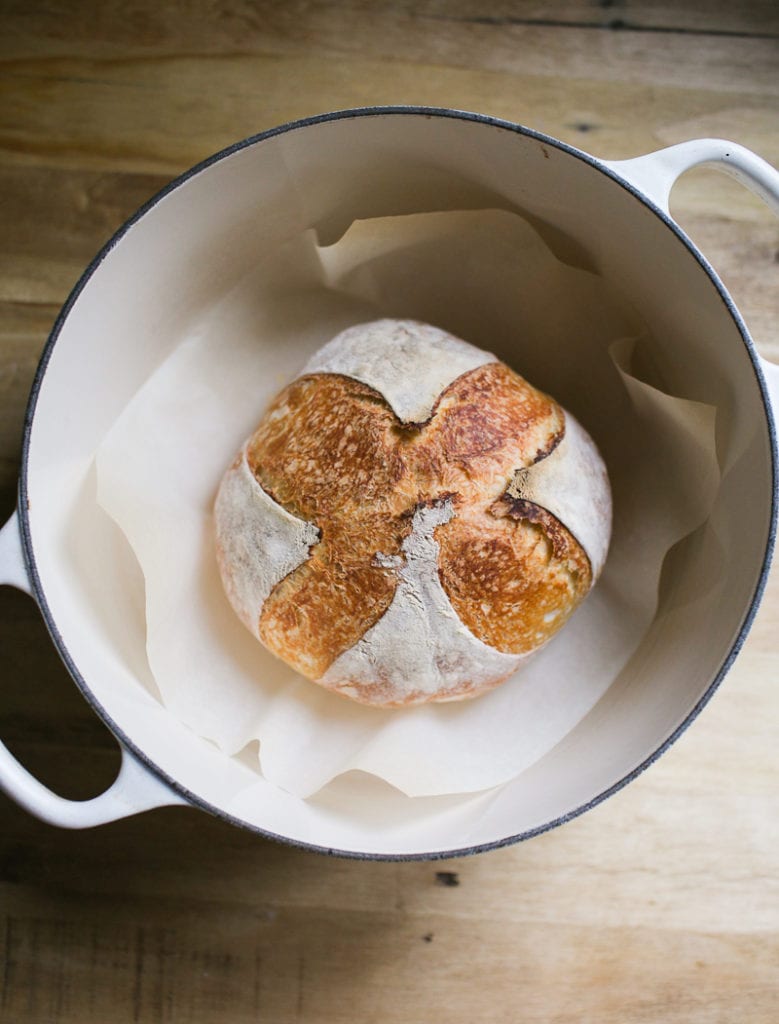
Bakers all over the world insist on using bread flour to create incredible homemade sourdough bread. It’s prized for its high protein and gluten content, which typically gives sourdough bread recipes a lofty, high rise. But what if you don’t have any bread flour? Can you make crusty, artisan sourdough with all purpose flour instead?
The answer is yes, you most certainly can! But in my experience, you’ll have to make additional adjustments as you go along- you can’t just swap one flour for another. In this post, I’ll explain the process step-by-step. You’ll gain the tools and confidence you need to make incredible sourdough bread with all purpose flour (and for my UK & Aussie readers that’s “plain flour” for you!).
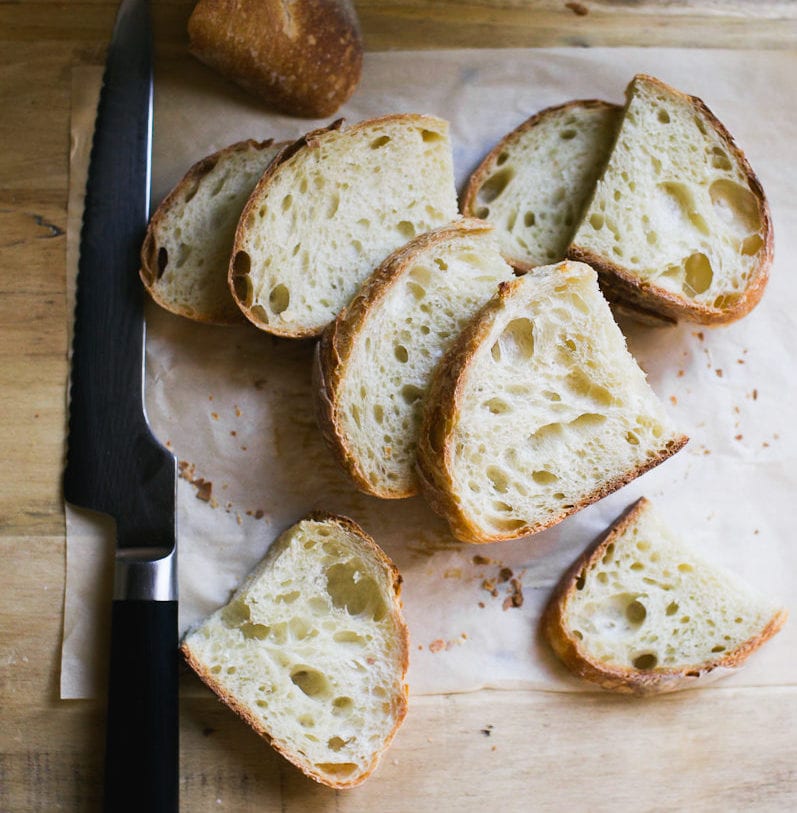
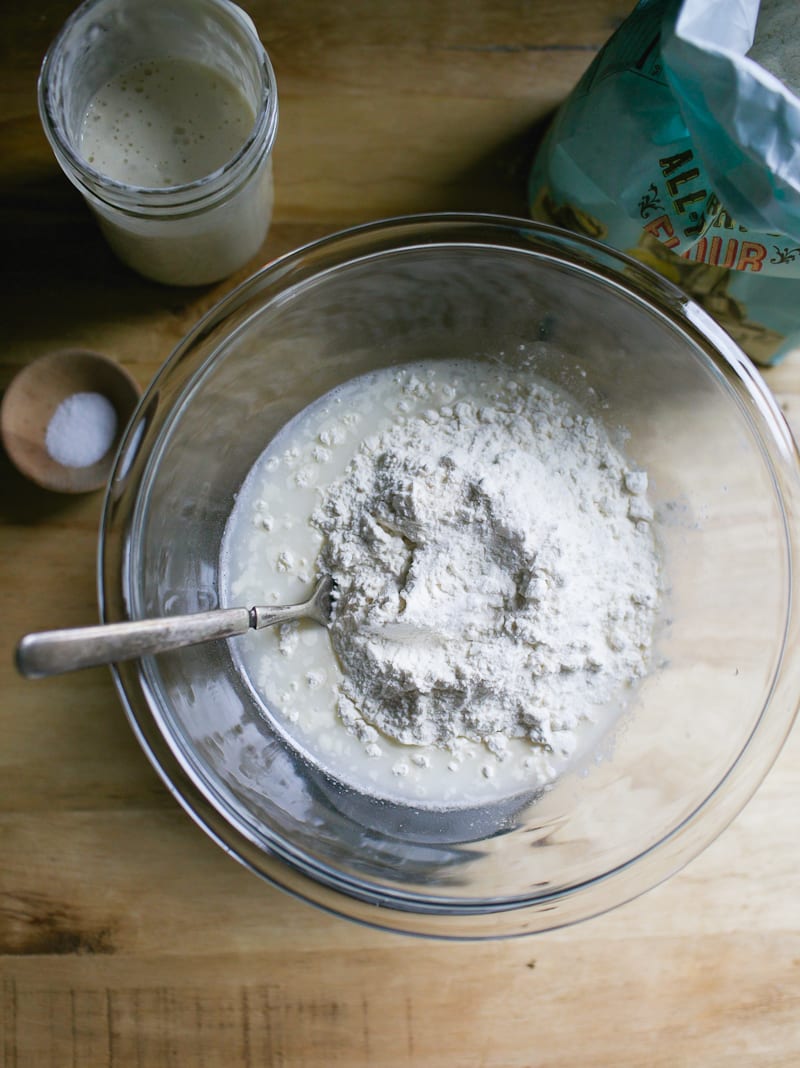
All Purpose Flour vs. Bread flour: What’s The Difference?
Generally speaking, it all boils down to protein content.
When compared side by side, bread flour has a higher protein content than all purpose flour.
High protein = better gluten development, which in most cases yields a higher rise.
I typically use King Arthur flour for bread baking. Their bread flour contains 12.7% protein, and their all purpose flour contains 11.7%.
This recipe was formulated to work with KAF all purpose flour and Trader Joe’s all purpose flour (which in my opinion, is comparable). I talk more about flour in this post.
TIP: Protein content will vary across the board. This means you’ll get different results from brand to brand. I highly recommend sticking with ONE BRAND at first. This way, you’ll get a feel for how that specific flour performs; it will be your reference point for future adjustments.
How to Use All Purpose Flour in Bread Baking
Substituting all purpose flour in a sourdough recipe that specifically calls for bread flour is not always an even swap.
You’ll need to REDUCE the total amount of water first.
All purpose flour absorbs less water than bread flour, which can make the dough too sticky to work with otherwise.
This can lead to flat, dense, and gummy loaves. You don’t want that.
Ok, So Reduce the Water by How Much?
I typically suggest reducing the water by 15-30g to start.
Why the range?
It depends on the recipe, how much starter it calls for, and what brand of flour you’re using etc.
You’ll have to play around with the texture of the dough, adjusting the flour/water until it “feels right,” which can be frustrating if you just don’t have the experience.
It requires practice, patience and persistence.
So, for now, let’s focus on the visual and tactile tools to help guide you instead.
How to Make Artisan Sourdough with All Purpose Flour: A Step By Step Guide
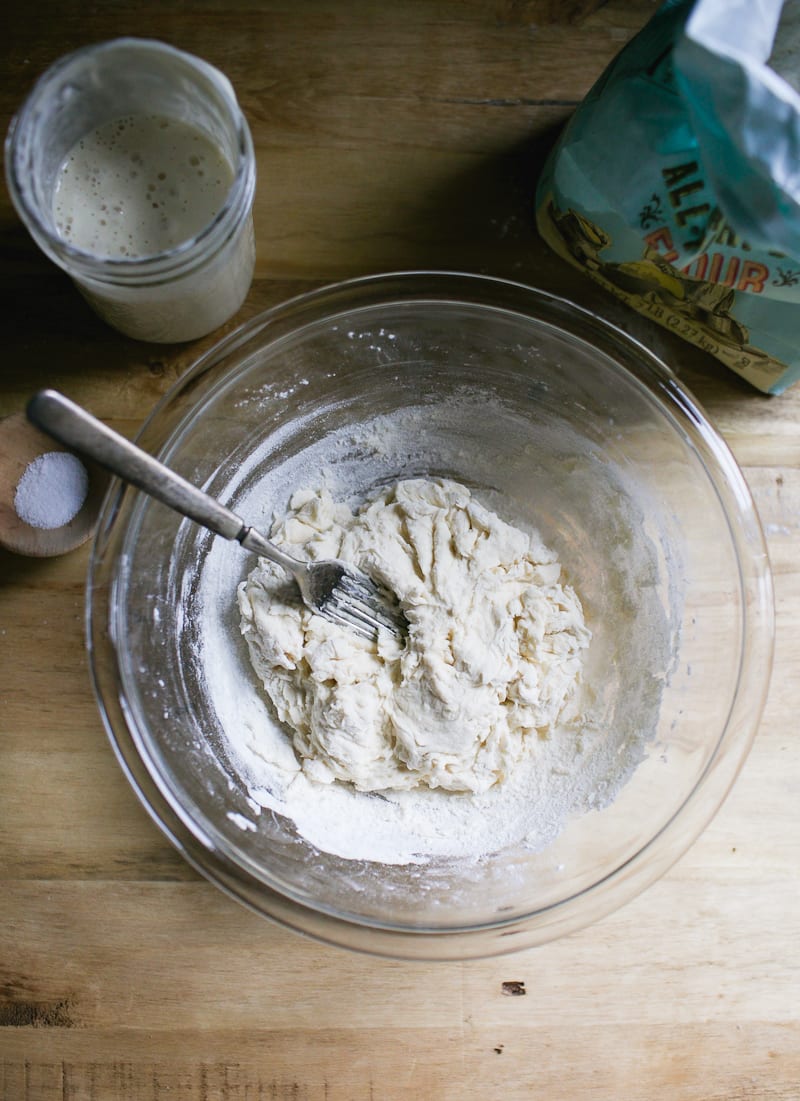
A Few Notes: This recipe makes a small sourdough loaf, perfect for 2-4 people. I prefer smaller loaves for beginners as they are more manageable to handle. Instructions for a larger, standard size are included in the recipe at the end of this post. For baking tools, please visit my shop. You will need a digital kitchen scale to weigh your ingredients (for accuracy and best results) and a Dutch oven for baking (or another oven-safe pot with lid).
Mix the Dough
In a large bowl, whisk the starter and water together. Add the flour and salt. Mix with a fork to combine.
Once it becomes too stiff to continue, finish mixing by hand until a rough and shaggy dough forms.
This is what the dough should look like after you’ve finished mixing it…
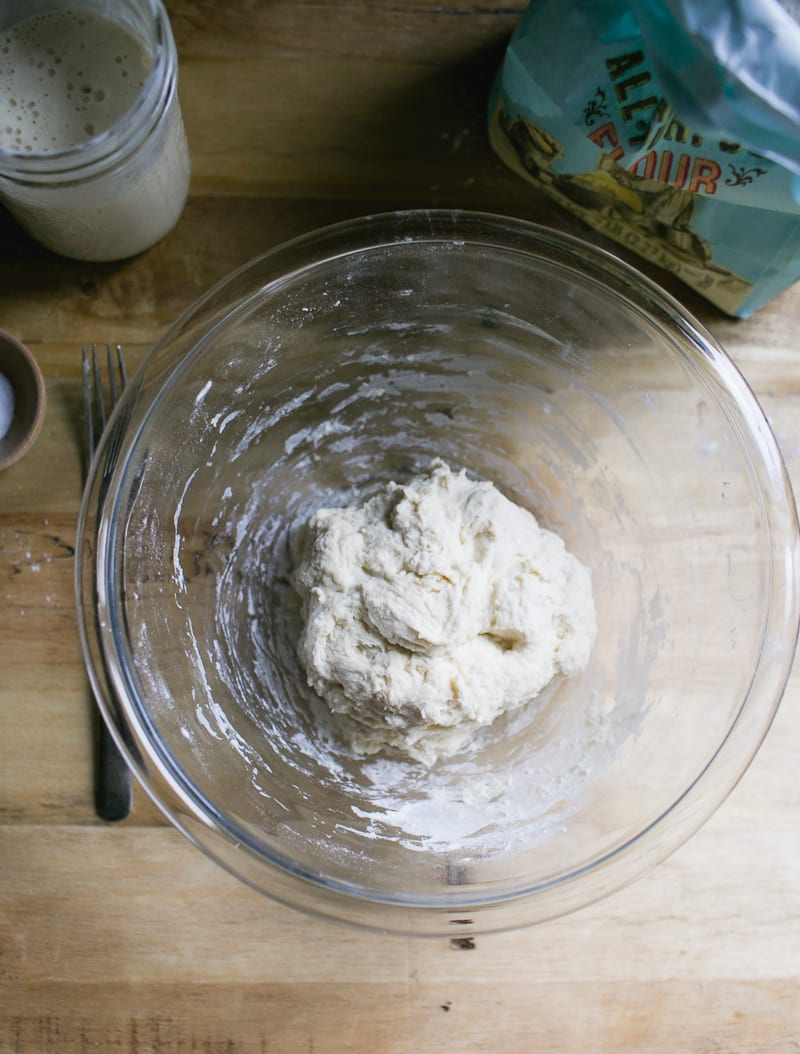
Now, cover the bowl with a damp towel or plastic wrap and let rest at room temperature for 30 minutes.
After the dough has rested…
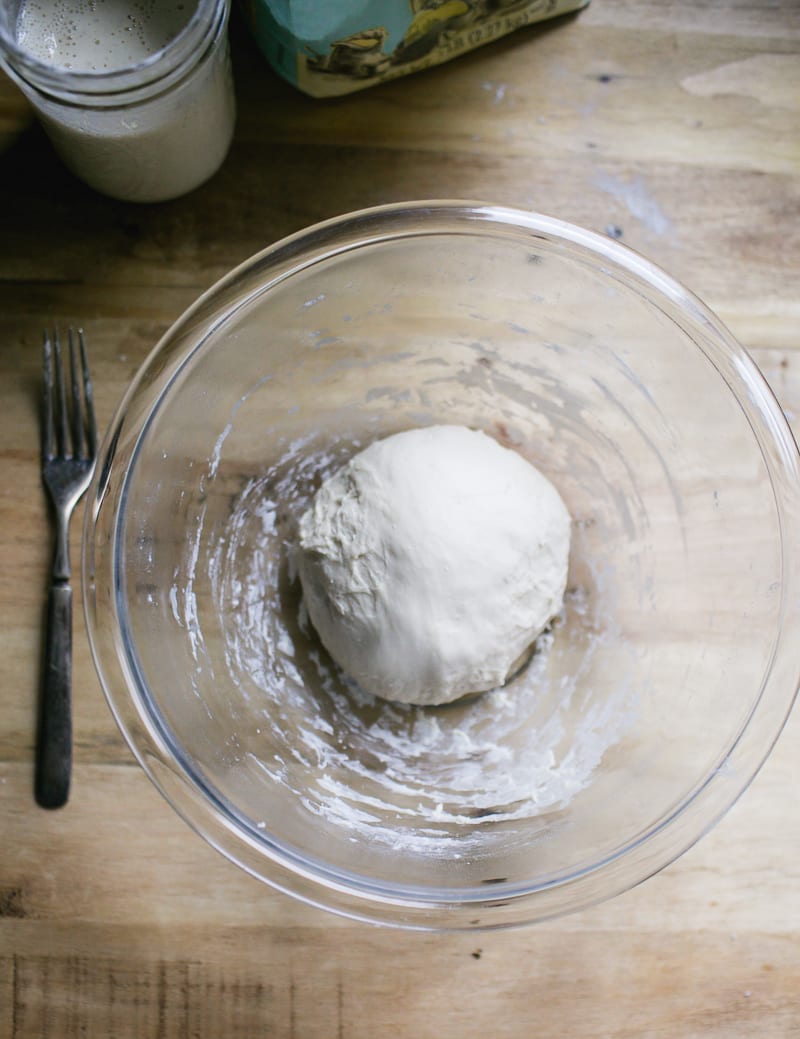
Work the dough into a ball. It will appear smooth on the surface with a few tears.
Heads up: this is your last chance to significantly adjust the texture of the dough. So take note of how it feels!
At this point, the dough should feel soft and stretchy… not wet, overly sticky, or soupy.
TIP: If the dough feels too wet (and this can happen depending on the brand of flour you’re using), add 1 tbsp. of flour after the first 30 minute rest. Mix thoroughly by hand, adding more flour as needed. If you think it’s too dry, add 1 tbsp. of water and see how you go. Not so bad right? Just a little back and forth until it “feels right.” You can’t really mess it up.
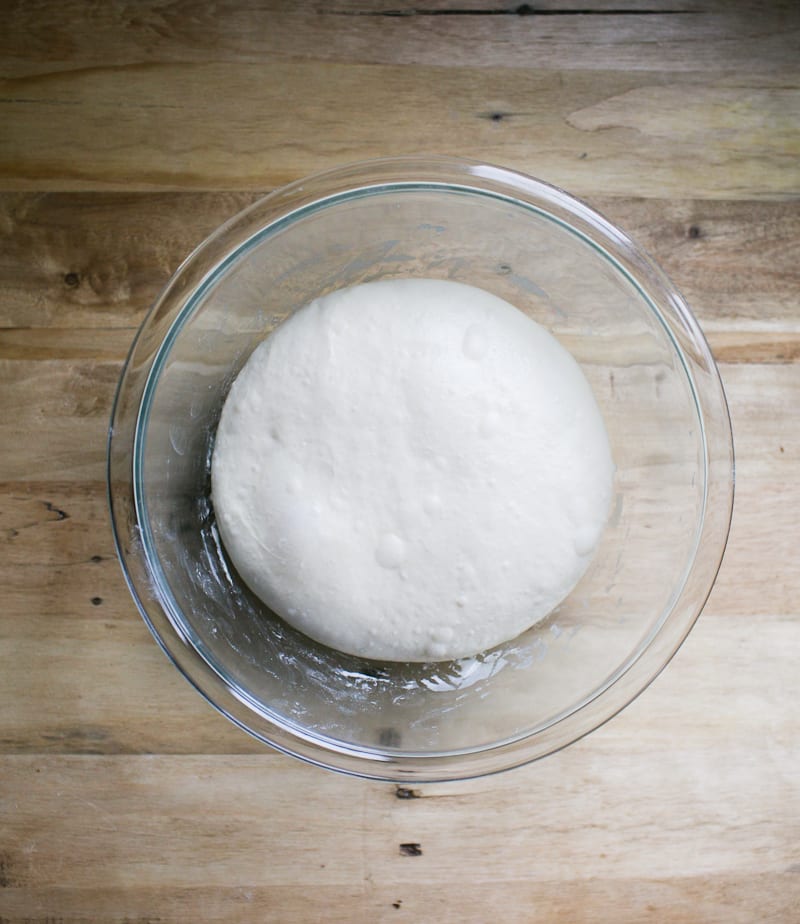
Bulk Rise
Cover the bowl and let rise overnight, about 10-12 hrs. at room temperature (68 F). The dough is ready when it has doubled in size.
TIP: If using a standard 8-inch mixing bowl (pictured above), the dough should rise to about 1/2- 2/3’s up the sides when ready (remember, this is a small loaf).
Stretch And Fold The Dough
This technique is optional and is done during the bulk rise.
It will strengthen the gluten, incorporate air into the dough and add height to the finished loaf.
To begin, about 30 minutes to 1 hour into the bulk rise, start your first stretch and fold.
Grab a portion of the dough and stretch it upwards. Then fold it over towards the center of the dough. Give the bowl a one-quarter turn and repeat (stretching the dough upwards and then folding it over) until you have come full circle to complete 4 folds or 1 set. Do another set about 30 minutes to 1 hour later.
Here’s a video!
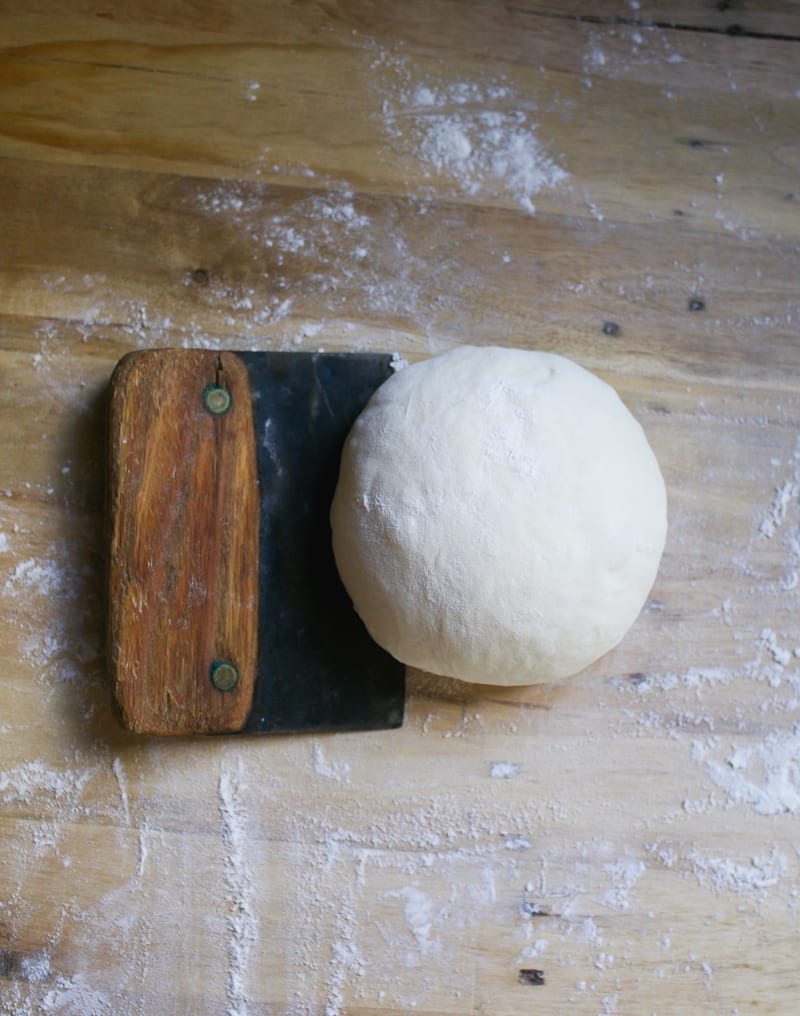
Shape the Dough
The following morning, line a small bowl with a cotton or linen cloth. Sprinkle with flour.
You’re going to shape the dough twice to build extra strength.
Preshape
Remove the dough onto a floured surface. To shape the dough into a round, starting at the top, gently fold the dough over toward the center. Give it a turn and fold over the next section. Repeat until you have come full circle.
Using a bench knife, scoop up the dough and flip it over (the smooth side should be facing up). Cover and rest for 20-30 minutes.
Final Shape
After the dough has rested, flip it over again (the smooth side should be facing down now). Shape it again following the steps above. Flip it back over.
With floured hands, gently cup the dough and pull it toward you in a circular motion to tighten its shape.
Place the dough into the lined bowl, seam side up. Cover the dough with the cloth overhang.
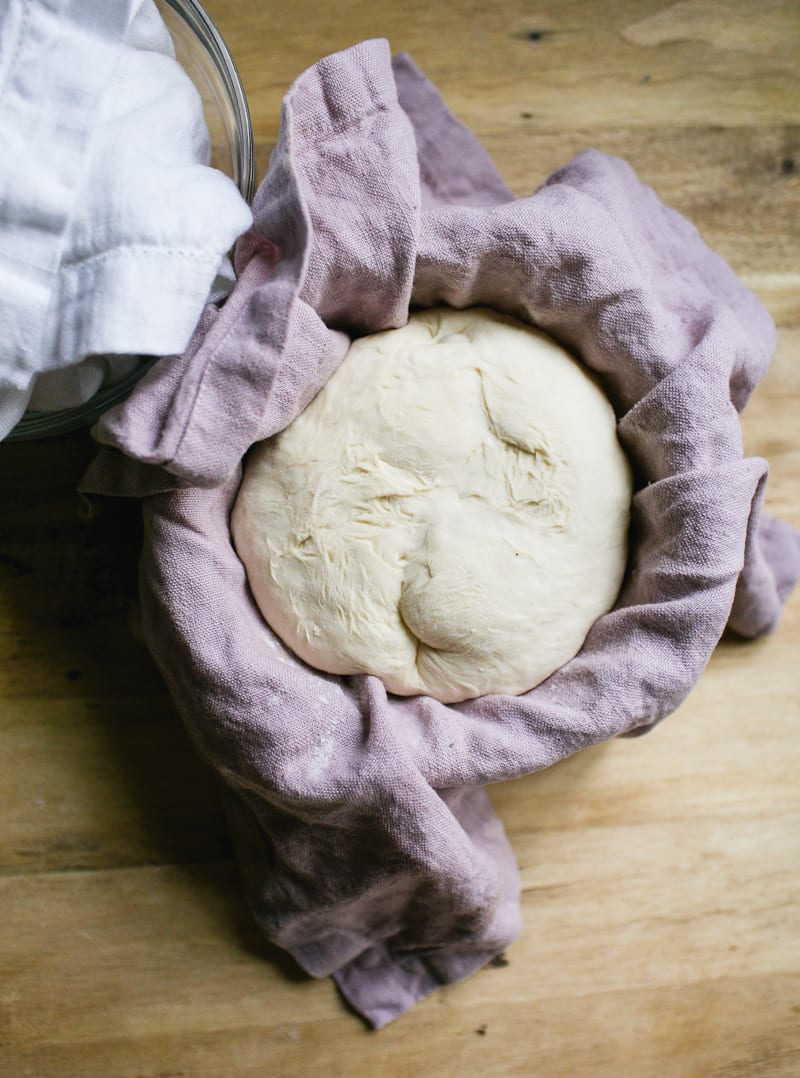
Second Rise
Now the dough needs to rise again.
Rest at room temperature for 30 minutes to 1 hour; the dough is ready when it has puffed up and looks plump. It does not double in size.
Preheat the oven to 450 F.
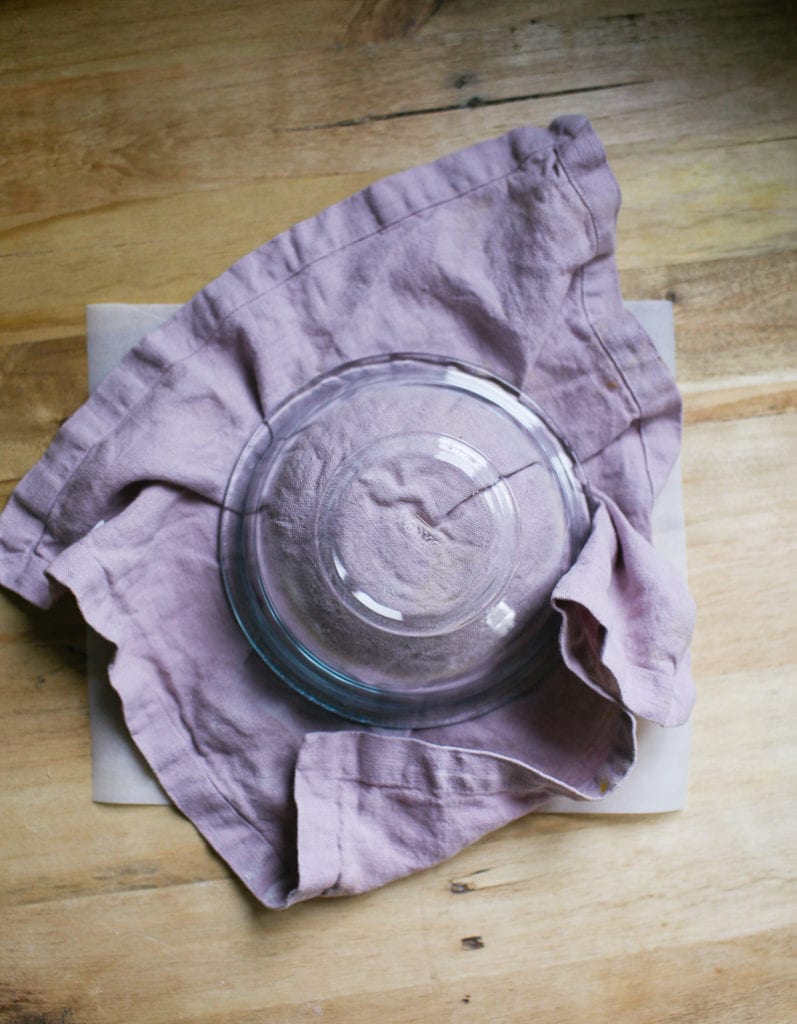
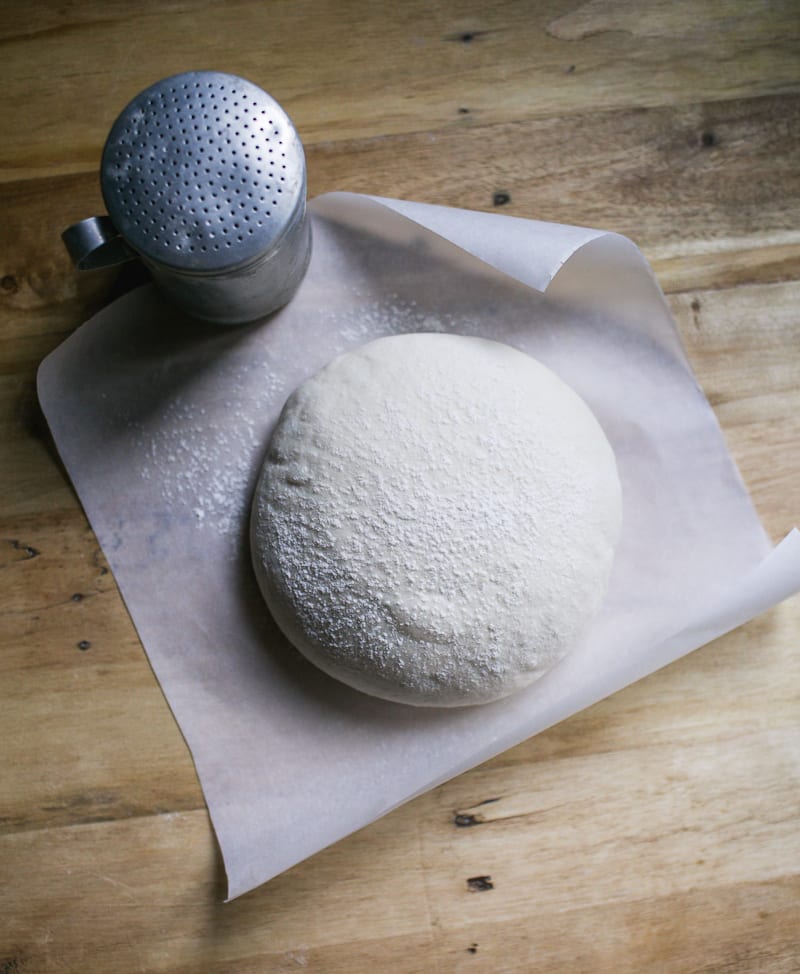
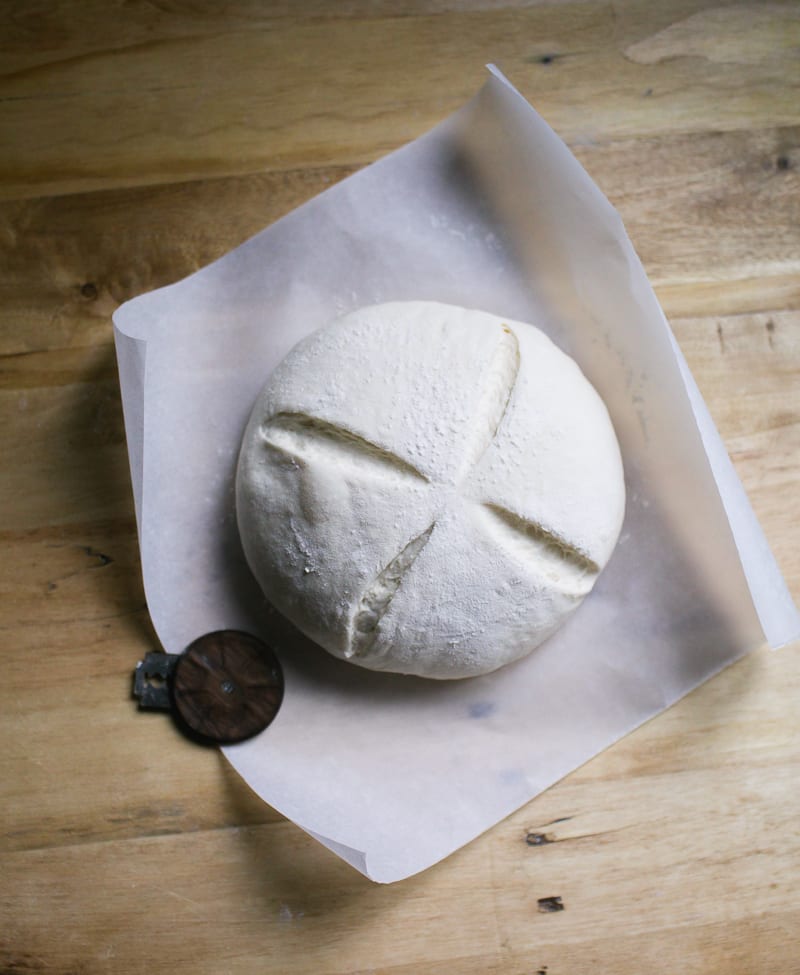
Score the Dough
Invert the bowl of dough onto a sheet of parchment paper. Remove the bowl and cloth.
Sprinkle the dough with flour and smooth the surface with your hands.
Using a bread lame or a small serrated knife (I used my UFO lame), score the dough at 12, 3, 6 and 9 o’clock, turning the parchment paper as you go. Make quick, decisive cuts using the tip of the blade.
Here’s a video!
Lift up the dough while still on the parchment paper, and place it into a Dutch oven. Pop the lid on top.
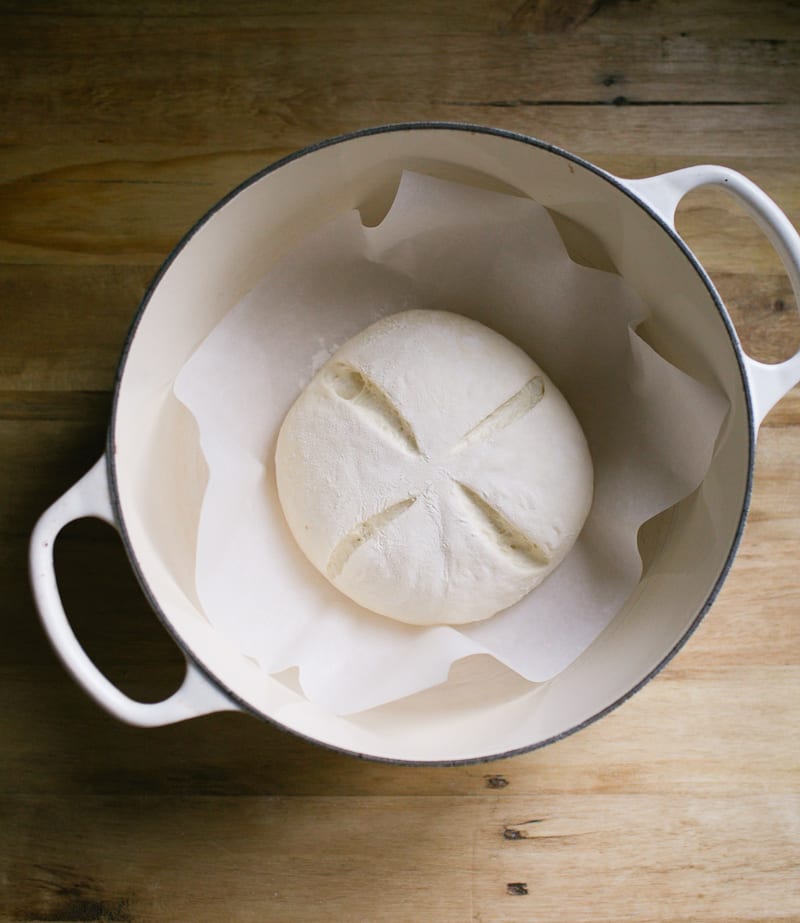
Bake the Dough
Place the pot into the preheated oven, center rack. Reduce the heat to 425 F.
Bake the dough, with the lid on for 20 minutes. Then, remove the lid and bake for an additional 30-35 minutes or until golden brown.
Here’s what the dough will look like after you take off the lid (please ignore my sparkling oven…).
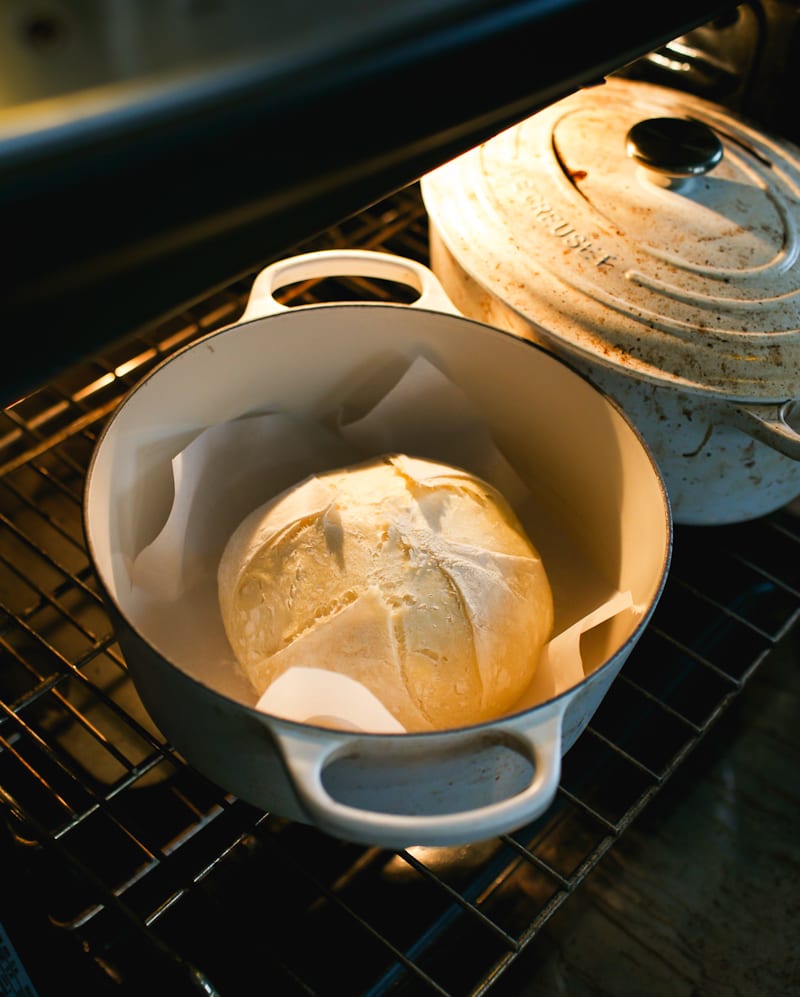
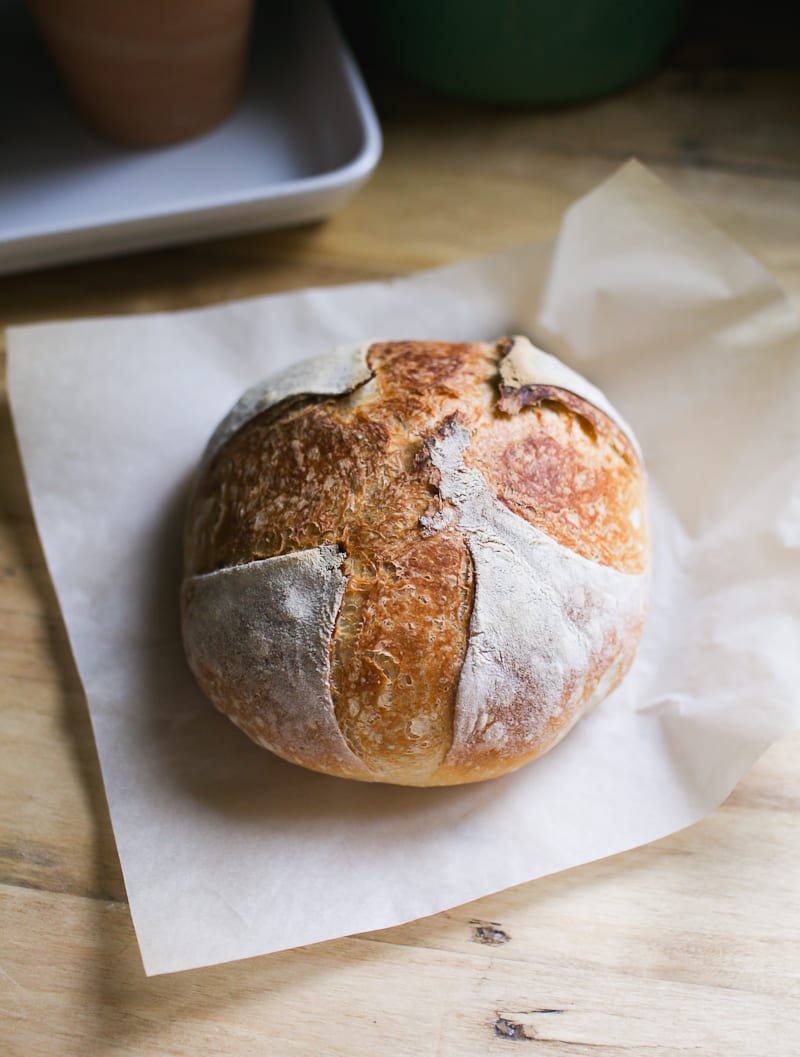
Let it Cool
Check out that oven spring!
Don’t you just want to rip off a chunk?
Unfortunately, you’ll have to wait at least an hour my friends. The texture might be gummy and wet if you jump the gun.
Storage
Sourdough is best enjoyed on the same day it’s baked.
To maximize freshness, cool completely and store at room temperature wrapped in plastic, reusable beeswax wrap or a bread bag for 1-2 days.
Sourdough can also be frozen, for up to 2-3 months. Defrost at room temperature and warm @ 300 F before serving.
Taste Test
This artisan sourdough with all purpose flour produces a crusty loaf with a smooth interior crumb.
We love it for sandwiches, french toast and crostini. It’s a versatile everyday option.
And in comparison to a bread flour loaf, none of us could really tell the difference!
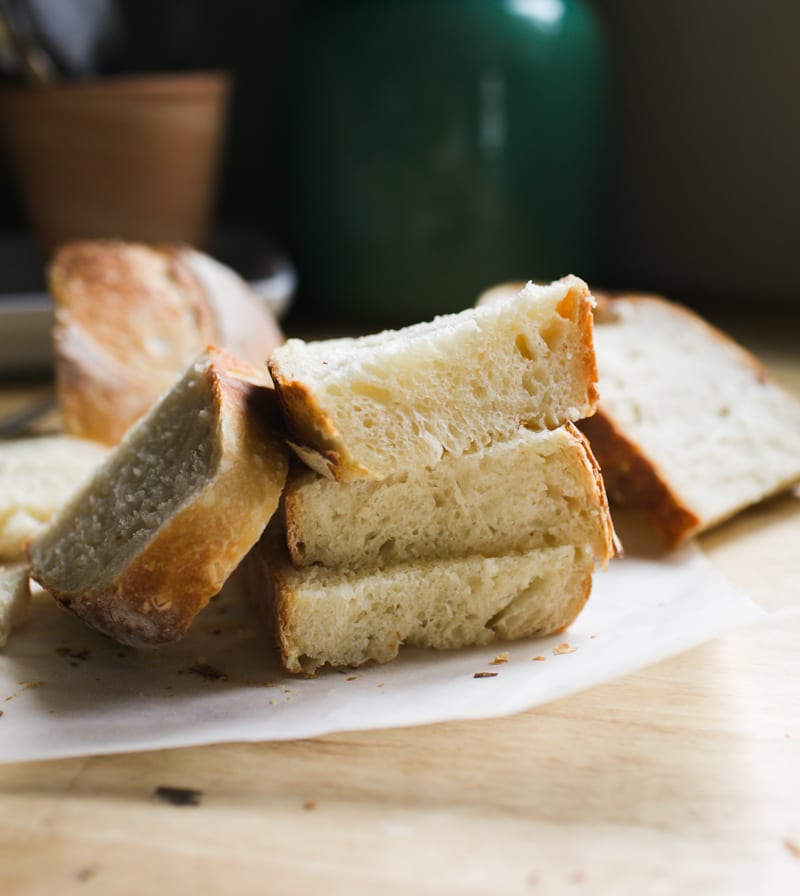
My Baking Schedule
All bakers need somewhat of a game plan before diving in.
Here’s what I do: I’ll make the dough in the evening to rise overnight (start the night before). It will be ready to bake the following morning. If it’s warmer than 68 F, I’ll start later in the evening to avoid over proofed dough. The timing is flexible.
In the evening…
- 7:00 PM: Make the dough/ Rest for 30 minutes to 1 hr.
- 8:00 PM: 1st Stretch & Fold (optional)
- 9:00 PM: 2nd Stretch & Fold (optional)
- Cover bowl with plastic wrap and let rise overnight on the kitchen counter, for 10-12 hrs @ 68 F.
The following morning…
- 7:00 AM (or earlier): Check the dough. Give it more time to rise, if needed.
- 7:05-ish AM: Preshape
- 7:30 AM: Shape
- 7:35 AM: Second Rise/ Preheat Oven
- 8:05-ish AM: Bake
Additional Resources
- How to Stretch and Fold Sourdough {Video}
- How to Shape a Round Sourdough Boule {Video}
- Artisan Sourdough Made Simple {Book}
- Sourdough Bread: a Beginner’s Guide {Recipe}
- Light Whole Wheat Sourdough Bread {Recipe}
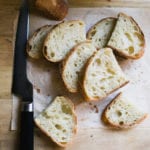
Artisan Sourdough with All Purpose Flour {soft, crisp & chewy!}
- Cook Time: 50 minutes
- Total Time: 50 minutes
- Yield: 1 small loaf (2-4 ppl)
- Category: Sourdough Bread
- Method: Oven-Baked
- Cuisine: American
- Diet: Vegetarian
Description
No bread flour? No problem! My artisan sourdough with all purpose flour is an excellent substitute. This recipe yields a smaller sized loaf (perfect for up to 4 people) with a crisp crust and a smooth, interior crumb.
Notes & Substitutions
This recipe was formulated to work with King Arthur & Trader Joe’s all purpose flour, which contains 11.7% protein. If using another brand, please see my tip in the recipe below for adjusting the texture of the dough, if needed.
For accuracy and best results: please weigh your ingredients using a kitchen scale.
Ingredients
For a small loaf:
- 50 g (1/4 cup) bubbly, active sourdough starter
- 165 g (1/2 cup + 3 tbsp) water
- 5 g (1 tsp) fine sea salt
- 250 g (2 cups + 1 tbsp) all purpose flour (Trader Joe or King Arthur)
For a larger, standard size loaf:
- 50 g (1/4 cup) bubbly, active sourdough starter*
- 330 g (1 1/3 cup + 1 tbsp) water
- 9 g (1 1/2 tsp) fine sea salt
- 500 g (4 1/4 cups) all purpose flour (Trader Joe or King Arthur)
*Note: I use 50 g of starter for both the small AND standard size loaf. Using a smaller amount of starter with an long, overnight rise will help to prevent over proofed dough in the morning.
Instructions
Make the Dough
In the evening, whisk the starter and water together in a large bowl. Add the flour and salt. Mix with a fork until a stiff dough forms, then finish by hand to fully incorporate the flour. It will feel rough and shaggy, and slightly sticky. Cover with a damp towel or plastic wrap and let rest at room temperature (68 F) for 30 minutes.
After the dough has rested, work the dough into a ball. To do this, grab a portion of the dough and fold it over, pressing your fingertips into the center. Repeat, working your way around the dough until it begins to tighten.
TIP: If the dough feels too wet (and this can happen depending on the brand of flour you’re using), add 1 tbsp. of flour. Mix thoroughly by hand, adding more flour as needed. If you think it’s too dry, add 1 tbsp. of water and see how you go.
Bulk Rise
Cover the bowl (damp towel or plastic wrap) and let rise overnight at room temperature. This will take about 10 to 12 hours at 68 F. The dough is ready when it no longer looks dense and has doubled in size. If using a standard 8-inch bowl, the dough will rise about 1/2 way up the sides.
Optional Step: about 1 hour into the bulk rise, do 1 set of stretch and folds. Repeat 1 hour later. This will increase the overall volume of the bread.
Shape the Dough
The following morning, line a small bowl with a cotton or linen cloth. Sprinkle with flour.
Important: You’re going to shape the dough twice to build extra strength.
Preshape
Remove the dough onto a floured surface. To shape the dough into a round, starting at the top, gently fold the dough over toward the center. Give it a turn and fold over the next section. Repeat until you have come full circle. Using a bench knife, scoop up the dough and flip it over (the smooth side should be facing up). Cover and rest for 20-30 minutes.
Final Shape
After the dough has rested, flip it over again (the smooth side should be facing down now). Shape it again following the steps above. Flip it back over. With floured hands, gently cup the dough and pull it toward you in a circular motion to tighten its shape.
Place the dough into the lined bowl, seam side up. Cover the dough with the cloth overhang.
Second Rise
The dough needs to rise again. Rest for 30 minutes to 1 hour. The dough is ready when it looks puffy and has risen slightly, but has not yet doubled in size.
Preheat your oven to 450. Cut a sheet of non-stick parchment paper to fit the size of your baking pot, leaving enough excess around the sides to remove the bread.
Score the Dough
Place the parchment over the dough and invert the bowl to release. Sprinkle the dough with flour and gently rub the surface with your hands. Using the tip of a bread lame, small, serrated knife or a razor blade, make four shallow 4-inch long cuts at 3, 6, 9, and 12 o’clock around the dough. Use the parchment paper to transfer the dough to the baking pot.
Bake the Dough
Reduce the heat to 425 F. Bake the dough on the center rack for 20 minutes, covered. Remove the lid, and continue to bake for 30-35 minutes and golden brown (40 minutes uncovered for the larger, standard loaf).
When finished, transfer to a wire rack. Cool for 1 hour before slicing, for best texture.
Notes
Sourdough is best consumed on the same day it is baked. To maximize freshness, cool completely and store at room temperature wrapped in plastic, reusable beeswax wrap or bread bag for 1-2 days.
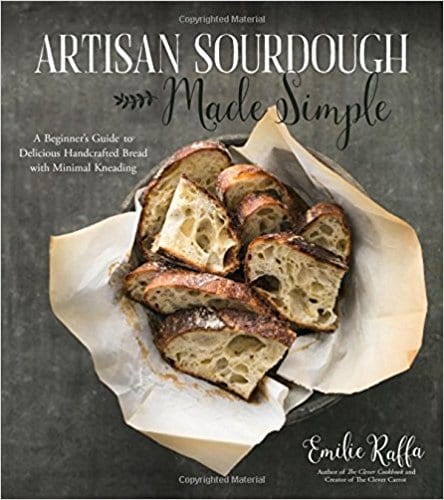

Comments
Britt says
The most perfect recipe. I baked a small loaf and the regular size loaf at the same time with this recipe, one for a friend and one for my family. Literally AMAZING. And my loaves look just like the photos. Thank you so much for another perfect recipe!!! I swear by your sourdough guides and recipes, they’re the only ones I use! Thank you, Emilie!!
Becky says
I am new to sourdough baking but this was the best flavor and process so far! Easy enough for a beginner. I’m getting better at it! The instructions are very easy. I like the density that the lower amount of starter and flour gives vs the ratios I was using. The dough is way easier to work with. I started with the smaller version and this morning I baked the big one. Can’t keep my hands off of it!
Carol says
I had a customer ask for a last minute artisan loaf. I found this recipe and went with it because I did not have enough time for my traditional high hydration dough. My starter was running low and REFUSED to get active like usual, but had some signs of activity after some time (was a high ratio feed). I followed your recipe to a T and went with it even though I planned to have the worst flop there was from the start. Woke up the next morning and the dough didn’t look like it did anything (again… used to a higher hydration), but decided to shape it and bake it anyway. The customer messaged me a photo of the crumb (my only requirement since I gave it to her free not knowing how it would turn out) and WOW! It was dang near perfect. This recipe works even for the most ridiculous circumstances that I seemed to have to go through. I’m going to make it for myself next time haha!
Thanks for another great recipe!